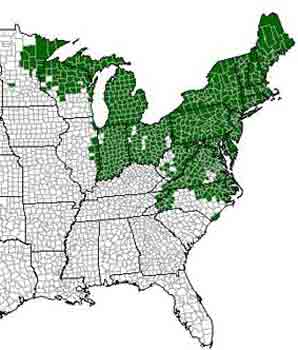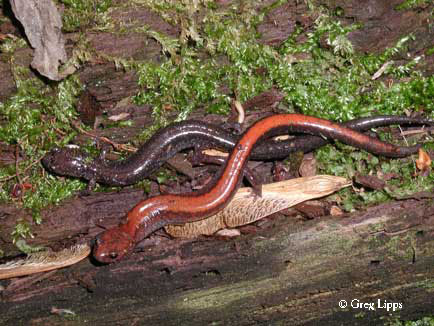
Redback Salamander
(Plethodon cinereus)
 |
 |
|
|
Distribution of the Redback Salamander (from the AR MI Atlas)
|
Two adult Redback Salamanders showing variation in color.
|
|
Description: A small (>5”) woodland salamander with short legs. The tail makes up less than half of the total length. The ground color is black to dark brown. Individuals may be of two common morphs. The striped morph has a broad, straight-edged, orange-red stripe extending down the back and onto the tail. The lead-back morph lacks the stripe. The underside is speckled black and white, with more black than the otherwise similar Ravine Salamander. |
||
Distribution in Ohio: Throughout the state. Recorded from 79 of Ohio’s 88 counties. |
||
|
|
||
Status in Ohio: Widespread and locally abundant. |
||
|
|
||
Habitat: Moist forests, especially forested, rocky hillsides. The Red-backed Salamander is usually found under rocks, logs, fallen bark, or leaf litter. Much of its life is spent underground. |
||
|
|
||
Life history: Eggs are laid in June, suspended like a bunch of grapes within a rotting log or under a rock. There are usually 3-14 eggs in a clutch, and the female attends to these until hatching in August. The larval stage takes place within the egg. The young become sexually mature 2 years later. |
||
|
|
||
Conservation: Red-backed Salamanders are tied to moist forest habitats. Destruction of these habitats is the greatest threat to populations. Logging of forests causes an increase in temperature and the rate of evaporation and also reduces the leaf litter so important for this species and its prey. Like all lungless salamanders, pollutants, including herbicides and pesticides, are easily absorbed and toxic to the Red-backed Salamander. |
||
Last modified:
|
Ohio Amphibians · Ohio Salamander Web · Ohio Salamander Species · Amphibian Habitats · Salamander Monitoring |
|